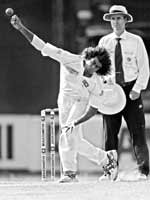| On bowlers
and techniques
There is a phrase in the game that,
“no two bowlers actions are exactly the same.”
It is very true, although as youngsters many tend to
copy a favorites approach, there will be some part that
will become different as the action becomes established.
For a few that established natural action is good enough
to last through a career. For most, adjustments have
to be made and the earlier the better, before bad habits
creep in. There is also a small percentage of players
with unorthodox bowling actions. They cannot be changed
or corrected. Sri Lanka’s Muttiah Muralitharan
and Lasith Malinga are the best examples of a spinner
and paceman who defy bowling techniques. It’s
difficult, almost impossible to copy their actions and
bowl successfully.
 |
| Lasith Malinga |
The schools under 15 and 17 seasons
are coming to an end, with the under 17 quarter finals
to be played early next week. Having watched a number
of young bowlers in action, it is evident that bowlers
have to be coached more at these levels. The main learning
years on all aspects of the game are between ten and
seventeen. It is therefore essential that a sound technical
foundation is instilled and obtained during these years.
Bowlers must be first educated to
employ either a front on or side on action. Before the
emergence of bowlers like Joel Garner, Malcolm Marshall
and Colin Croft of the West Indies, the coaching manual
only preached of bowling with a side on action. This
trio and many others coming into the game in the 1970’s
bowled in a way that came naturally to them.
It also brought about another issue
where bowlers got themselves into mixed action positions.
A situation where the one half of the body did the opposite
to the other. This led to the two types of actions,
where should the feet land parallel to the crease, the
non bowling arm should be pushed across for the head
to be in position to look at the batsman from over the
shoulder. The open chested or front on action is the
opposite.
Pace bowlers, medium pacers and wrist
spinners must adhere to bowling with one or the other
type of action. It is then that best bowling results
could be obtained. This will also minimize injury. A
mixed action results in a lot of strain on the back
and the knees and ankles too. So, finger spinners will
get away with a somewhat mixed action, particularly
if that is what comes naturally to them.
Two bowlers currently in international
cricket who could be sighted as examples in the two
types of actions are Makhaya Ntini, the South African
paceman and Shane Warne the Aussie leg spinner. Ntini,
is a front on bowler. He bares his chest to the batsman
at the point of delivery. His feet also land, with feet,
toes pointing in the same direction. With practice he
has mastered the art and delivers all the variations
of pace bowling, pretty briskly. Mind you, he is not
a very big man, when compared with many of the quick
bowlers of today.
Shane Warne delivers absolutely side
on. It is this classic action, combined with a massive
competitive spirit and heaps of stamina to bowl long
spells that has made him the bowler that he is. His
record tells the story.
The game’s governing body must
do more to educate school coaches on the subject of
coaching bowlers. Much more must be done to pick-up
young talented bowlers and work on their actions. After
all, it is the bowlers who win matches for their team.
|
